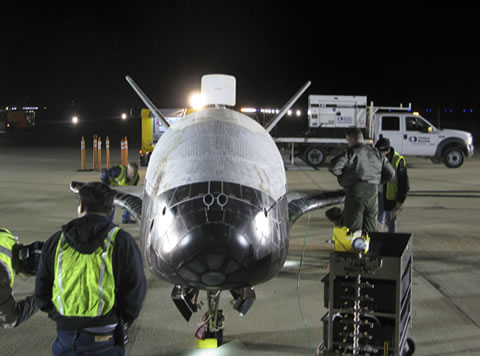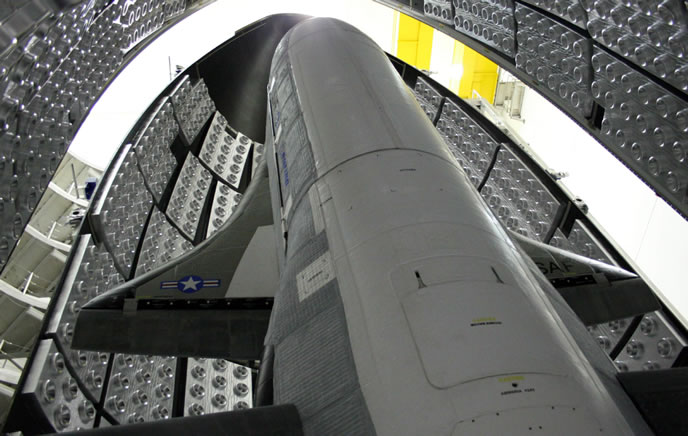The U.S. Air Force launched the newest and most advanced unmanned re-entry spacecraft today, April 22nd, 2010 at 7:52PM from Cape Canaveral Air Station, Fla. The spacecraft was launched on an Atlas V expendable launch vehicle, the 8.9 meter long, five ton X-37B Orbital Test Vehicle (OTV) is a ‘risk reduction’ vehicle designed for space experimentation that explores concepts of operation for a long-duration, reusable space vehicle. According to Mr. Gary Payton, Air Force Deputy Under Secretary for Space Programs, the first mission of the X-37B OTV will evaluate new concepts of operation employing a reusable autonomous, unmanned spacecraft. Experimentation will be performed on the mission in space and on the ground, upon its return, assessing the cost and complexity of the turnaround cycle – repairing the vehicle after the flight and preparing it for a new mission in a timely and cost effective manner. Following a series of in-orbit experiments, the vehicle will be commanded to autonomously perform the reentry maneuver to land at the Vandenberg Air Force Base in California, gliding through the atmosphere, on its 4.5 m’ span wings.

“The X-37B is an important step in the effort to make space access more routine, affordable, and responsive,” said David Hamilton Jr., the Air Force Rapid Capabilities office director. “The technologies and concepts of employment that are proven by the Orbital Test Vehicle will be folded into development programs that will provide capabilities for our warfighters in the future.”

The OTV will demonstrate a number of advanced technologies; some have already been tested on modern spacecraft but have not been used on reusable vehicles. These include thermal protection systems, utilizing advanced ceramic tiles made of silica, expected to better isolate the vehicle from heat developed through reentry, these tiles are also expected to better withstand ablation and not absorb moisture, enhancing the vehicle’s ability to launch under weather conditions that would have restricted current Shuttle operations. The OTV also uses advanced power sources based on solar array powered lithium-ion batteries, replacing the hydrogen-oxygen fuel cells used on the Space Shuttle. Other experiments to be performed on board involve the new avionics systems, guidance, navigation and control, systems, high temperature structures and seals.

A vehicle like the X-47B is designed to carry out extended space missions of up to 270 days (the spacecraft landed on December 3, 2010 50 days short of that target), providing a flexible platform offering the air force rapid access to space, deploying multiple small satellites into orbit in quick succession. According to Payton, the Air Force hopes for turnaround time similar to the SR-71 Blackbird – several days or few weeks, rather than months required for refurbishing the Space Shuttle for space missions. Eventually, the Air Force plans to operate a fleet of reusable spacecraft – Boeing is already producing the next X-47B, to be delivered next year.
Although the X-37B represents a new generation of spacecraft, it is based on a design dating back to the mid- 1990s, at the time when NASA explored several concepts reusable space vehicles but hasn’t flown any of them to space. Among these programs were the X-33, X-34, and X-37 vehicles. All have flown in the atmosphere in captive and free flight experiments but were not launched into orbit. The OTV is the first vehicle since NASA’s shuttle orbiter that has the ability to return experiments to Earth for further inspection and analysis.
NASA’s original X-37 program began in l999 and ran until September 2004 when NASA transferred the program to DARPA. NASA envisioned building two vehicles, an Approach and Landing Test Vehicle, or ALTV, and an Orbital Vehicle. The ALTV validated flight dynamics and extended the flight envelope beyond the low speed/low altitude tests conducted by NASA from 1998 through 2001 on the X-40A, a sub-scale version of the X-37 developed by Air Force Research Labs. DARPA completed the ALTV portion of the X-37 program in September 2006 by successfully executing a series of captive carry and free flight tests. NASA’s X-37 Orbital Vehicle was never built: but its design was the starting point for the Air Force’s X-37B Orbital Test Vehicle program.
The X-37B program is now led by Air Force Rapid Capabilities Office, which expedite development and fielding of select Defense Department combat support and weapons systems. This program builds upon early development and testing conducted by officials from NASA, the Defense Advanced Research Projects Agency and the Air Force Research Laboratory. “The X-37B is the only self contained effort intended to be an economically viable experimental test platform on-orbit for months at a time and then return,” said David Hamilton Jr., the Air Force Rapid Capabilities office director. “The OTV has the potential to revolutionize how the Air Force operates in space by making space operations more aircraft like and adding in the capability for returnable plug-and-play experiments,” Mr. Hamilton added. “There is much to learn in the first few flights on the technologies used on this vehicle, how quickly it can be readied for a re-flight, and on the operational utility,” Mr. Hamilton said. “We have started discussions with Air Force Space Command (officials) to plan for the possibility for transition to an operational capability, but the system first must prove its utility and cost effectiveness during the test program.”




















